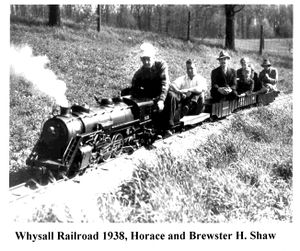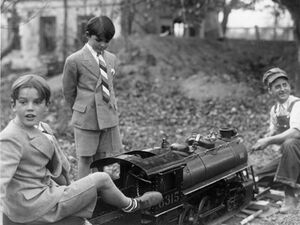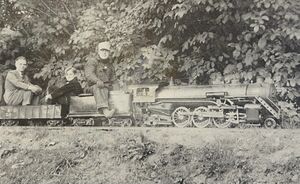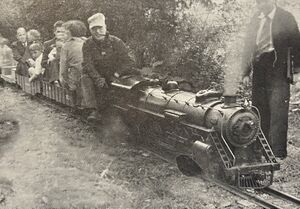Whysall Light Railway: Difference between revisions
| Line 25: | Line 25: | ||
: Back in July 1937, your Editor-In-Chief was bitten by the Live Steam Bug while running Horace Shaw's 1½ inch scale Pacific in Bloomfield Hills, Michigan, and never fully recovered. | : Back in July 1937, your Editor-In-Chief was bitten by the Live Steam Bug while running Horace Shaw's 1½ inch scale Pacific in Bloomfield Hills, Michigan, and never fully recovered. | ||
: About a year later, [[ | : About a year later, [[Cliff Pettis]], who is currently Vice President of the [[Southwestern Live Steamers]], attended an Open House at Shaw's [[Whysall Light Railway]] and took the photos shown here, and was also infected by the smell of coal smoke and cylinder oil. That's Cliffs son, Hugh, sniffing coal smoke in one photo and sitting in the riding car behind [[Horace Shaw]] in the other. Cliff went on to form [[Texas Railways]] in Houston, Texas, in 1947 and his patterns and designs were sold later to Robert Miller of [[Miller Backyard Railroad]] and thence to [[Bethlehem Pattern and Model Shop]] in Pennsylvania. To complete the circuit, they went back to [[Terry McGrath]] of the defunct [[Texas Railway Supply Inc]] and, as a result, some of these castings show up on just about every 1½" scale track in the country. | ||
: [[Horace Shaw]] is still interested, although not active, in the Live Steam Hobby at his home in Bloomfield Hills ... and many of us owe him a debt of gratitude for introducing us to the wonderful world of Live Steam! | : [[Horace Shaw]] is still interested, although not active, in the Live Steam Hobby at his home in Bloomfield Hills ... and many of us owe him a debt of gratitude for introducing us to the wonderful world of Live Steam! | ||
<gallery widths=300px heights=400px> | <gallery widths=300px heights=400px> | ||
File:HoraceShaw WhysallLightRailway 1938-ClifPettis-1.jpg|Horace Shaw at the throttle of 4-6-2 Pacific on his Whysall Light Railroad, Summer 1938. Seated behind him is Hugh Pettis, son of | File:HoraceShaw WhysallLightRailway 1938-ClifPettis-1.jpg|Horace Shaw at the throttle of 4-6-2 Pacific on his Whysall Light Railroad, Summer 1938. Seated behind him is Hugh Pettis, son of Cliff Pettis of Houston, Texas. Photo by Cliff Pettis. From Live Steam Magazine, March 1979. | ||
File:HoraceShaw WhysallLightRailway 1938-ClifPettis-2.jpg|Horace Shaw, photo by | File:HoraceShaw WhysallLightRailway 1938-ClifPettis-2.jpg|Horace Shaw, photo by Cliff Pettis. | ||
</gallery> | </gallery> | ||
Revision as of 16:56, 10 July 2025
The Whysall Light Railway was a private railroad constructed in the 1930's by Horace P. and Brewster H. Shaw of Bloomfield Hills, Michigan. The railroad was subsequently purchased by Stephen and David Booth and renamed the Tipsico Lakeshore Railroad.
History
From Railroad Magazine, 1939:
- Another midget line in Michigan is the Whysall Light Railway at Bloomfield Hills, whose engines and rolling stock were built as a hobby under the critical eye of Jesse Gall, superintendent of production at Ternstedt plant 16 in Detroit. The WLR is one-quarter of a mile long, with 7-1/4 inch gauge, eight pound mine rails, and a pebble-ballasted roadbed. The locomotive, a live steamer, can haul ten loaded cars at speeds up to thirty miles per hour with no trouble at all.
From Tipsico Lakesore Railroad:
- What was once a dream of brothers Steve and Dave Booth’s in 1935 (top photo) at age 10 and 8, became a reality in 1947 with the purchase of the 7-1/4 inch gauge Whysall Light Railway from Horace P. Shaw. Started in the early 1930’s, Shaw’s railroad had stood idle for many years on his Bloomfield Hills property near what is now the Woodward Avenue entrance to the Cranbrook Educational Community. Absorbed by the railroad bug, Stephen and David, and many enthusiastic volunteers, would labor for the next 15 years to complete a 1/2 mile point to point run.
This is one of the few known photos of Horace Shaw’s Railroad, years before it was purchased by Stephen and David Booth, and renamed the Tipsico Lakeshore. The steam locomotive and All of the cars seen in the photo, are still in use on the TLS today.
The Booth Brothers at Whysall Light Railroad in the late 1930's. Is Horace Shaw at the head of the locomotive?
Bill Fitt
Bill Fitt, publisher of both Live Steam Magazine and Modeltec, wrote the following in Live Steam Magazine March 1979:
- Back in July 1937, your Editor-In-Chief was bitten by the Live Steam Bug while running Horace Shaw's 1½ inch scale Pacific in Bloomfield Hills, Michigan, and never fully recovered.
- About a year later, Cliff Pettis, who is currently Vice President of the Southwestern Live Steamers, attended an Open House at Shaw's Whysall Light Railway and took the photos shown here, and was also infected by the smell of coal smoke and cylinder oil. That's Cliffs son, Hugh, sniffing coal smoke in one photo and sitting in the riding car behind Horace Shaw in the other. Cliff went on to form Texas Railways in Houston, Texas, in 1947 and his patterns and designs were sold later to Robert Miller of Miller Backyard Railroad and thence to Bethlehem Pattern and Model Shop in Pennsylvania. To complete the circuit, they went back to Terry McGrath of the defunct Texas Railway Supply Inc and, as a result, some of these castings show up on just about every 1½" scale track in the country.
- Horace Shaw is still interested, although not active, in the Live Steam Hobby at his home in Bloomfield Hills ... and many of us owe him a debt of gratitude for introducing us to the wonderful world of Live Steam!



